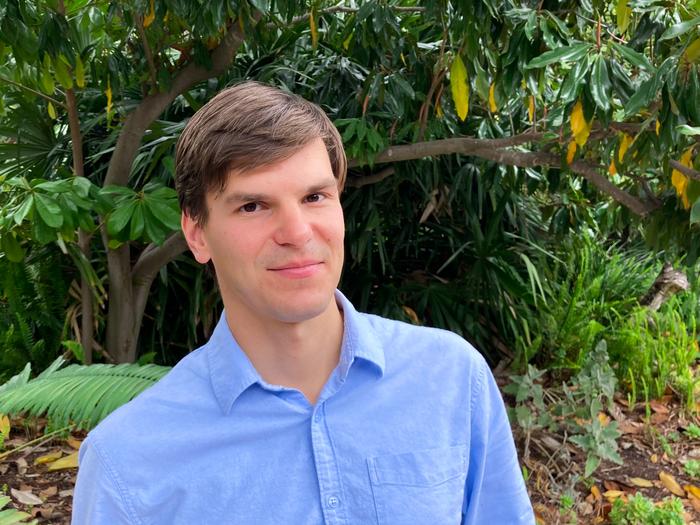Laszlo Horvath, an early career physicist at the U.S. Department of Energy’s (DOE) Princeton Plasma Physics Laboratory (PPPL) stationed at General Atomics in San Diego, is the winner of the 2022 Károly Simonyi Memorial Plaque from the Hungarian Nuclear Society. Established in 2007, the plaque “recognizes Hungarian researchers and engineers with outstanding achievements in the field of fusion plasma physics and technology.”

Credit: Eszter Mics
Laszlo Horvath, an early career physicist at the U.S. Department of Energy’s (DOE) Princeton Plasma Physics Laboratory (PPPL) stationed at General Atomics in San Diego, is the winner of the 2022 Károly Simonyi Memorial Plaque from the Hungarian Nuclear Society. Established in 2007, the plaque “recognizes Hungarian researchers and engineers with outstanding achievements in the field of fusion plasma physics and technology.”
Horvath learned he had won the Simonyi Memorial Plaque not long after he was hired by PPPL in November 2022. “I feel honored that my research has been acknowledged by the Hungarian fusion community,” he said. “It’s also an honor to have my name mentioned alongside that of Miklós Porkoláb, the prize’s first recipient.”
Horvath received the award because of his research focused on the behavior of plasma, the fourth state of matter that makes up 99% of the visual universe and fuels ring-shaped fusion facilities known as tokamaks. He is interested in gaining a greater understanding of how neutral hydrogen gas enters the plasma within tokamaks and splits into electrons and atomic nuclei, a process known as fueling that can stoke the fusion reactions that power the sun and stars. Scientists around the world are trying to harness fusion as a way to generate electricity without producing greenhouse gases and long-lived radioactive waste.
“I was extremely impressed when I heard Laszlo had won this award,” said PPPL physicist Alessandro Bortolon, who heads the PPPL collaboration with General Atomics and supervises Horvath. “It’s important that students can see him and realize that they, too, could make impacts in the field early in their careers. This award is really inspiring for the younger generation.”
Horvath graduated from the Budapest University of Technology and Economics in 2015 with a master’s degree in physics. He earned a doctorate in plasma science and fusion energy from Britain’s University of York in 2019, and then held a postdoctoral position at Britain’s Culham Centre for Fusion Energy, where he conducted research using a tokamak known as the Joint European Torus (JET).
At General Atomics, Horvath manages a complex sensor that measures the plasma within DIII-D, the tokamak the company operates for the DOE. Known as LLAMA, the diagnostic observes the light emitted by hydrogen gas. Studying this light helps scientists learn more about how the gas interacts with the plasma edge and the fueling process in general. A greater understanding of fueling could help physicists keep the plasma stable and hot, making the fusion reactions more efficient.
Horvath finds plasma physics research rewarding in part because the tight international fusion community fosters a sense of belonging and purpose. “Everyone in the fusion world shares the goal of making fusion a practical source of electricity, and no matter where I am around the globe, people in the community feel the same way,” Horvath. “So, there are strong connections between us.”
When he’s not managing sophisticated scientific machinery or conducting research, Horvath enjoys exploring San Diego with his wife, Eszter. “We have been going to museums and theaters, as well as attending concerts,” he said. “We also like to go on hikes and spend time at the beach. In fact, I am planning to buy a surfboard!”
Horvath encouraged prospective plasma physics students to take the leap and join the plasma physics community. “This is an exciting time in the field,” he said. “Even beginning scientists can contribute to making practical fusion energy a reality.”
PPPL, on Princeton University’s Forrestal Campus in Plainsboro, N.J., is devoted to creating new knowledge about the physics of plasmas — ultra-hot, charged gases — and to developing practical solutions for the creation of fusion energy. The Laboratory is managed by the University for the U.S. Department of Energy’s Office of Science, which is the single largest supporter of basic research in the physical sciences in the United States and is working to address some of the most pressing challenges of our time. For more information, visit https://energy.gov/science




